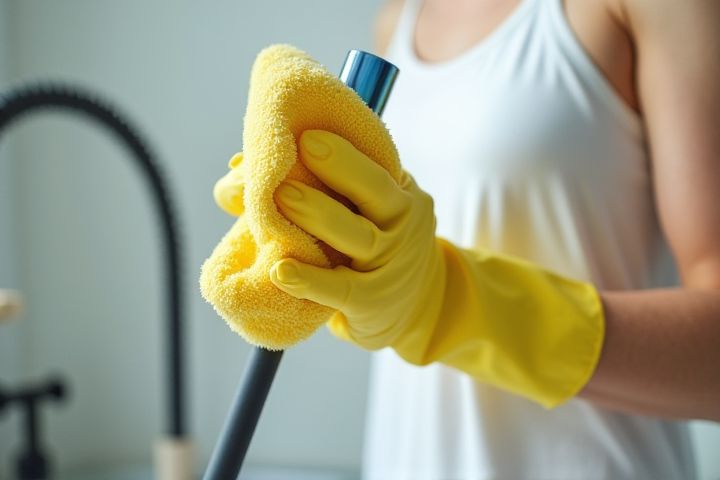
To maintain a pristine home with minimal effort, utilize baking soda as a natural deodorizer, perfect for carpets and upholstery. White vinegar serves as an effective multi-surface cleaner, breaking down grease and removing stains while leaving surfaces streak-free. For dust-prone areas, microfiber cloths trap particles better than traditional dusters, ensuring your environment remains allergen-free. To speed up the vacuuming process, create a cleaning schedule that designates specific tasks to daily or weekly intervals, minimizing overwhelm. Lastly, keep essential cleaning supplies in a portable caddy, making it easier to tackle messes promptly and efficiently throughout your home.
What Are The Best House Cleaning Hacks
Use vinegar for glass cleaning.
Vinegar is a powerful, natural cleaner that effectively removes streaks and grime from glass surfaces, ensuring a crystal-clear finish. Mix equal parts of distilled white vinegar and water in a spray bottle for optimal glass cleaning results. To enhance the cleaning process, use a microfiber cloth, which minimizes scratches and maximizes absorption. By incorporating this eco-friendly solution, you can achieve spotless glass while reducing reliance on commercial cleaning products.
Baking soda for deodorizing carpets.
Baking soda effectively deodorizes carpets by neutralizing odors without harsh chemicals. To utilize this natural deodorizer, generously sprinkle an even layer of baking soda over your carpet and let it sit for at least 15 minutes, or ideally overnight for tougher smells. Afterward, vacuum thoroughly to remove both the baking soda and the trapped odors, leaving your carpet fresh. Incorporating this method into your cleaning routine can significantly improve the air quality in your home and prolong the life of your carpets.
Lemon for removing water stains.
Lemon, with its natural acidity, effectively removes water stains from various surfaces. For glass, combine lemon juice and water in a spray bottle, apply it to the stained area, and wipe with a microfiber cloth for a streak-free shine. On faucets and sink surfaces, rub a lemon half directly onto the stain, allowing it to sit for 5 to 10 minutes before rinsing with warm water. For countertops, a paste made from lemon juice and baking soda can tackle tougher stains--spread it on, let it sit for a few minutes, then scrub and rinse.
Microfiber cloths for dusting.
Microfiber cloths are highly effective for dusting due to their ability to trap dust and allergens, thanks to their fine fibers. To enhance their performance, lightly dampen the cloth with water or a mild cleaning solution before use, optimizing dust retention and preventing particles from becoming airborne. For optimal results, use separate microfiber cloths for different surfaces, such as electronics, furniture, and glass, to avoid cross-contamination. Regularly laundering your microfiber cloths without fabric softeners will maintain their dust-attracting properties and extend their lifespan, ensuring your cleaning efforts remain efficient.
Dryer sheets for baseboard dusting.
Using dryer sheets for baseboard dusting effectively attracts dust and helps eliminate static buildup. Simply rub a used dryer sheet along the baseboards, allowing its anti-static properties to repel dirt while leaving a fresh scent. This method not only cleans but also can prevent dust from settling quickly, making future cleanings easier. Incorporating this simple hack into your cleaning routine can enhance the overall freshness of your home environment.
Baking soda and vinegar for unclogging drains.
Baking soda and vinegar are powerful natural agents for unclogging drains, offering an eco-friendly solution to tough blockages. Begin by pouring 1 cup of baking soda down the drain, followed by 1 cup of vinegar; this combination will produce a fizzy reaction that helps break down debris. After letting the mixture sit for 30 minutes, flush the drain with 2 to 3 cups of hot water to clear out any remaining gunk. For persistent clogs, repeating this process a few times can provide further relief, making your plumbing flow smoothly once again.
Olive oil for polishing stainless steel.
Olive oil is an effective, natural solution for polishing stainless steel surfaces, leaving them shiny and streak-free. To use it, simply apply a small amount of olive oil to a soft cloth, then gently buff the stainless steel in the direction of the grain. This method not only enhances the luster of your appliances but also provides a protective layer that helps prevent fingerprints and smudges. For optimal results, consider using this hack monthly to maintain a gleaming finish on your kitchen surfaces.
Use squeegee to remove pet hair.
A squeegee is an effective tool for removing pet hair from various surfaces, particularly upholstered furniture and carpets. By dragging the rubber blade across the fabric, you can easily gather pet hair into clumps, simplifying the cleaning process. This method not only saves time but is also more efficient than traditional vacuuming, especially for stubborn fur. You can achieve remarkable results by using this technique just once a week, ensuring your home remains pet hair-free.
Coffee filters for mirrors and windows.
Coffee filters are an effective and eco-friendly option for cleaning mirrors and windows, providing a lint-free finish. Their unique texture allows for the absorption of dirt and grime without leaving any streaks behind, making them superior to traditional paper towels. To use, simply dampen a coffee filter with your preferred glass cleaner or a mixture of vinegar and water, then wipe the surface for a sparkling shine. You'll find that the 10 to 15 filters in a standard pack can last multiple cleaning sessions, offering an economical solution for your cleaning routine.
Use toothpaste for removing scuff marks.
Toothpaste, a common household item, can effectively remove scuff marks from various surfaces, especially walls and floors. Simply apply a small amount of non-gel toothpaste to a soft cloth or sponge and gently rub the stained area in circular motions for optimum results. After the scuff mark lifts, wipe the area clean with a damp cloth to remove any residue, leaving the surface spotless. This easy cleaning hack not only saves time but also eliminates the need for harsh chemicals, making it a safe option for homes, particularly those with children.
